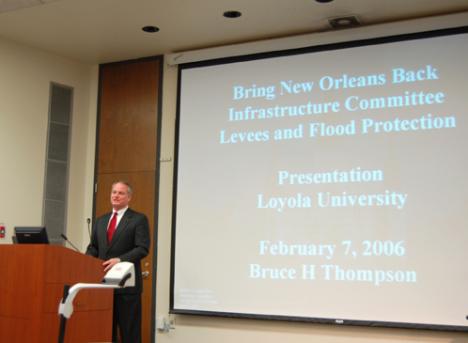Prominent local business leaders are stepping forward to lead New Orleans to recovery. These leaders participated in a panel on Feb. 7 to discuss the economic effects of Katrina and how the city plans to get back on its feet.
The event began with Kevin Pollard, president of GlobalSolve Management, a financial consulting firm that gives advice to companies in economical distress.
“We’ve had a stronger response from countries outside the U.S. to help us here,” Pollard said of the response to New Orleans’ crashing economy. In times of need, he said, people look up to major businesses for leadership.
Bruce Thompson, president of Thompson Equipment Co. and member of the mayor’s Bring Back New Orleans committee, followed by adding that the disaster was not caused by nature, but by human mistakes. He gave a PowerPoint presentation displaying the failures of the levees and what his company plans to do to protect the city. Ideas include a floating barge-pump system, jetties along canal openings and the compartmentalization of the waterways within the city.
“None of these recommendations interfere with the environment, nor with the Army Corp. of Engineers’ levees already in place,” Thompson said.
Charles Nelson, president of Wademar S Nelson & Co., believes that what caused some of the levees to crumble was barges slamming into them.
“The residents nearby complained of loud crashing. It most have sounded like someone kicking a 5,500-gallon drum,” said Nelson.
Chris Vondura from the Port of New Orleans discussed the problems they had getting the docks ready to receive shipment. The Port of New Orleans generated $37 billion in national economic output before the storm.
The port hosted three “floating dormitories” that housed employees and members of the maritime community. They also successfully shipped out a cargo of steel to the Hyundai plant on Sep. 12.
Pam Ryan, member of the cultural board of the Bring New Orleans Back Commission, wants to restore the New Orleans arts committees. She said that culture and the arts hold the key to the economic future of the city.
“It will remind us why we are building,” she says. “It is the most magnetic way to inspire our friends from around the world to join us in our renaissance.”
Some of Ryan’s goals include investing in creative people, developing e-commerce for artists, teaching cultural traditions to the youth, and attracting private investing for cultural endeavors.
Corrado Giacona, president of Giacona Corporation, had a more unique approach to restoring the New Orleans economy. Giacona has a lot of faith in other countries and feels it is they who have done the most in helping to rebuild. Therefore, he has designed an international community 40 city blocks-wide that will house 10 buildings side by side.
Each building will represent a different country, and will contain a parking garage on the first levels, a shopping and dining level, and offices and condos for local and visiting businessmen. The buildings will be interconnected by a gondola.
“It will be like a business Epcot in New Orleans,” said Giacona.
The panel discussed how these businesses survived the storm and what they are doing to help the city come back to normal.
The discussion was sponsored by the Loyola International Business Organization, Students In Free Enterprise, Economics Club, Delta Sigma Pi, American Marketing Association, the Financial Management Association and the International Student Association.
Michelle Lopez can be reached at mplopez@loyno.edu.






